
Red = Combined Frequency Response, Blue = Infinite Baffle Response

Red = Driver Output, Blue = Pipe Output
I'm putting this page up prematurily. Several related topic are covered that should be split out into their own pages. But there is imformation here that would help those not versed in TL theory or practice. So, here it is!
Almost all of the information on this site relates to pipes that use the pipe resonanse to extend the bass down as much as a half octave below what is possible with vented boxes. The advantages of resonant pipes are the obvious low bass and also the virtual elimination of back-wave reflection through the cone. The penalty is very large cabinet size relative to sealed or vented boxes.
The large cabinet size starts to become untenable with drivers around 8" and larger. Happily, these larger drivers also have substantially lower fs values than smaller drivers. This allows for a different approach to cabinet design. Where smaller drivers require the pipe resonance to lower f3, larger drivers go sufficiently deep on their own that the pipe output is not needed at all. We are entering the realm of the infinite baffle speaker.
At this point, I need to digress for a moment and discuss the model I use, the Martin King MathCAD worksheets and the model used by George Augspurger for his AES paper and Speaker Builder articles. You can go to the references and read about the math. Here I only want to show the similarities and differences. The MathCAD verson the the Vifa P17WJ example, figure 19 and 20 from the Speaker Builder article, Part 3:

Red = Combined Frequency Response, Blue = Infinite Baffle Response

Red = Driver Output, Blue = Pipe Output
(The driver that will be used for this discussion is the Peerless 850146, A 10" driver with fs = 27, Qts = 0.46, and Vas = 68. As you might have quessed, this discussion is part of the preliminary investigation for my DIY 2003 entry.)
First, let's look at the driver mounted on an infinite baffle. This was modeled with a 1000 liter box. This provides both a base line and a sanity check that the model is working correctly.

Infinite Baffle
The first TL example is a "Rule of Thumb" TL. The length of the pipe is 1/4 wave-length at fs. The wide end area is 2*Sd and the small end area is Sd. This is a pipe with dimensions 82" long, 100in2 at the wide end and 50in2 and the small end. The total pipe volume is 100 liters. This pipe has an f3 of 38Hz and f10 23Hz.

Rule of Thumb Pipe for Peerless 850146

Rule of Thumb Pipe for Vifa M25WO
Augspurger addresses the problem of differing driver parameters by providing a table of pipe parameters based on the driver Qts. Using the "opimized" values from Table 2, a pipe for the 850146 has dimensions 63" long, 64in2 at the wide end and 16in2at the small end. The total pipe volume is 33 liters. This pipe has an f3 of 42Hz and f10 28Hz.

Augsburger "Opimized" pipe for Peerless 850146

Augsburger "Extended" pipe for Peerless 850146

An optimized pipe for Peerless 850146
The Augspurger alignment for the Vifa M25WO is a much smaller pipe. The length is 54", 168in2 at the wide end and 63in2at the small end. The total pipe volume is 89 liters. This pipe has an f3 of 53Hz and f10 33Hz.
The moral of the story is that while you can shoe-horn a low Qts into a TL, the best results are obtained with a moderately high Qts of 0.4-0.5.

Augsburger pipe for Vifa M25WO

38 liter sealed box tuned to 44Hz Qc = 0.707

70 liter vented box tuned to 23Hz ~BB4

100 liter vented box tuned to 23Hz QB3
Room gain is hard to pin down. It depends on room size and shape, and is virtually unpredictable if the room is irregular, with lots of knooks and crannies, such as dining rooms and hallways. Anyway, looking over the literature and from my own experience, I declare room gain to be 3dB ad 40Hz and 6dB at 20Hz. YMMV. The point of this is that all models are anechoic. Once the speaker is put in a real room, there will be more bass than expected from the model. Applying room gain to the models of the 850146:
| Anechoic | With Room Gain | |||
| f3 | f10 | f3 | f10 | |
| Infinite Baffle | 45 | 20 | 29 | 12 |
| Rule-of-Thumb | 38 | 23 | 29 | 16 |
| Augspurger Optimized | 42 | 28 | 35 | 18 |
| Augspurger Extended | 36 | 22 | 26 | 15 |
| "Proposed" | 33 | 23 | 27 | 17 |
| Sealed | 42 | 28 | 33 | 19 |
| BB4 | 23 | 18 | 18 | 15 | QB3 | 20 | 17 | 17 | 15 |
All of the TL's and the sealed box give in-room f3 around 30Hz, which is perfect for classical music and acoustic instruments. With f10 below 20Hz, you can even expect to listen to some serious organ music. The two vented alignments go very low, but are going to have elevated bass, which is a bad thing for music, but a good thing for HT. The QB3 box will probably be unlistenable for music. The BB4 box, however, is going to be very good for HT, and, with the port plugged, will be a very good alignment for music. Just some off-topic thoughts.
I must admit that if I had the resources, I would go with IB using multiple 15" drivers with a large room or garage as a back chamber, or vented into an attic through a manifold. This is the route to the best, clean, uncolored bass. But, since I don't have the resouces, I built TL's. A TL does remove the back wave from the driver almost as effectively as an IB, giving the TL better, cleaner bass than any other type of box. The TL is, however, a much smaller package, being as it is not infinite, and additionally, it provides damping for the driver that the IB cannot.
The matter of driver damping is the reason that we can get much more SPL out of a TL, or sealed box for that matter, than we can out of the same driver on an IB. Here is the 850146 on an IB. The red line for the driver is exactly on the blue line, which defines the blue line as the IB condition in the remaining plots. The power level is 1 watt.
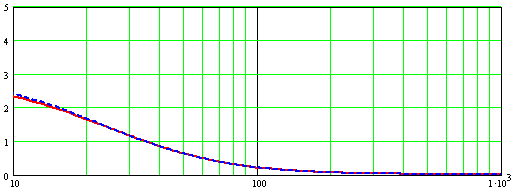
Infinite Baffle
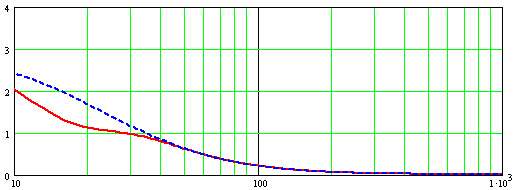
The Augspurger "Extended" TL
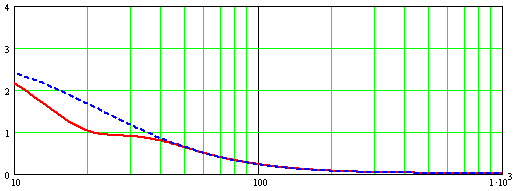
The "Proposed" TL
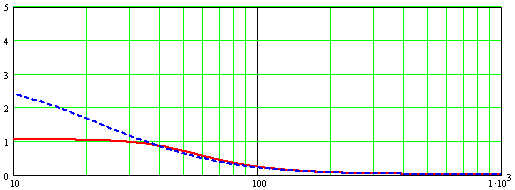
38 liter sealed box tuned to 44Hz
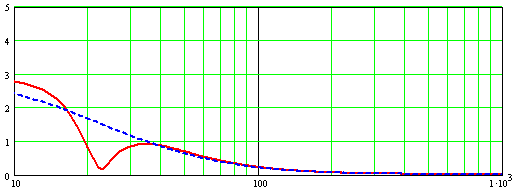
70l vented box tuned to 23Hz
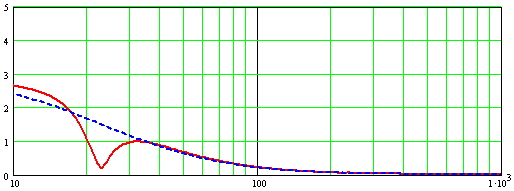
100l vented box tuned to 23Hz